 It is no coincidence that the Opel GT is often referred to the “Baby Corvette” due to its visual similarity to the third generation Chevrolet Corvette (the C3), with Opel and Chevrolet both members of the General Motors (GM) stable.
It is no coincidence that the Opel GT is often referred to the “Baby Corvette” due to its visual similarity to the third generation Chevrolet Corvette (the C3), with Opel and Chevrolet both members of the General Motors (GM) stable.
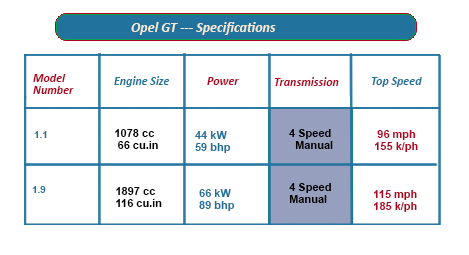 Speculation among those “ in the know” was that the design team at GM took their design inspiration for both the C3 Corvette and Opel GT from the Mako Shark II concept car designed by mega -talented designer Bill Mitchell.
Speculation among those “ in the know” was that the design team at GM took their design inspiration for both the C3 Corvette and Opel GT from the Mako Shark II concept car designed by mega -talented designer Bill Mitchell.
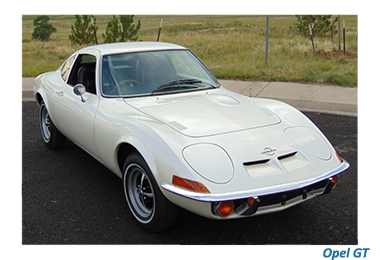 For a company that were never known for taking risks when it came to releasing a new model, heads must have been turning at the Paris Motor Show in 1968 when Opel took the wraps off their GT two-door hardtop, the first 2-door to be released by the company for more than sixty years.
For a company that were never known for taking risks when it came to releasing a new model, heads must have been turning at the Paris Motor Show in 1968 when Opel took the wraps off their GT two-door hardtop, the first 2-door to be released by the company for more than sixty years.
Opel, almost apologetically, declared that this new and exotic looking GT was nothing more than a prototype as if to fill an empty corner of their stand at Paris.
However, it soon became apparent that Opel had some serious intentions for the GT when the “ prototype was once again at the Frankfort Motor Show of the same year.
![]()
The design for the Opel GT originated from General Motors in Detroit, with the project headed by Clare McKichan.
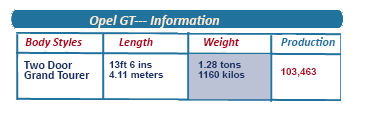 McKichan was one of GM’s top designers, who was involved in the development of the some of the United States most iconic “ muscle cars” of the late Fifties and early Sixties, among them the Chevrolet Corvair and Camaro.
McKichan was one of GM’s top designers, who was involved in the development of the some of the United States most iconic “ muscle cars” of the late Fifties and early Sixties, among them the Chevrolet Corvair and Camaro.
 McKichan was appointed as head of Opel Styling from 1962 to 1967, with GM anxious to provide some common language between the models being developed in the US and the UK and Western Europe.
McKichan was appointed as head of Opel Styling from 1962 to 1967, with GM anxious to provide some common language between the models being developed in the US and the UK and Western Europe.
After the initial furore, the Opel GT project appeared to have been put on mothballs, till it was eventually put into production in 1968, with considerable use being made of components that went into the Opel Kadett B, while body production was farmed out to prominent French body shop, Brissonneau & Lotz.
The general impression among menbers of the motoring press was that the GT was GM’s attempt to introduce a European version of the Corvette, feeling that the design and power capabilities of would suit continental drivers especially the West Germans who were allowed to hit speeds of 200km per hour on the Autobahns that were springing up all over Western Europe and the UK .
![]()
The GT was Opel’s first two-seater sportscar to be released in more than sixty years, marketed as a” sportscar for the younger driver”.
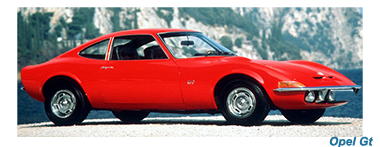
Available with either a 1.1-litre or 1.9-litre four-cylinder Kadett engines mated to a four-speed gearbox, the GT came fitted with independent suspension for increased road holding.
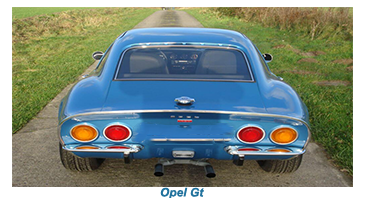 The GT’s 1.9-liter four-cylinder engine was obviously the most powerful, capable of generating a maximum of 100bhp.
The GT’s 1.9-liter four-cylinder engine was obviously the most powerful, capable of generating a maximum of 100bhp.
With a curb weight of just less than a ton the 1900GT could achieve 115mph ( around 200 k.ph) – a reasonable performance for a sports car in its category and of its era.
With the GT, Opel’s succeeded in shaking off some of their dowdy image, producing a car that looked good and drove well, thanks to its chiseled nose, swoopy curves and perfect proportions.
Despite GM’s early misgivings, the Opel GT was a partial success in a niche far removed from the company‘s comfort zone, remaining in production for around six years, selling approximately one hundred thousand models before Opel lost their sense of adventure and discontinued the model in 1973.






